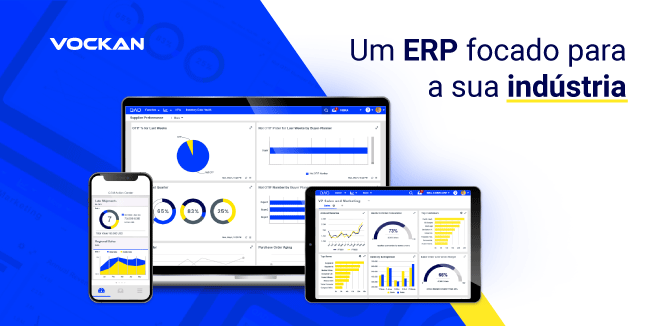Implementing an ERP enhances business management by integrating data, streamlining processes, increasing efficiency, and reducing costs. Successfully implementing an ERP system means revolutionizing the administration of a business. However, it is often a critical moment for companies, as it is complex, requires dedication, and can have significant impacts if operations are disrupted. Therefore, having good partners for ERP implementation is essential. They will provide the planning, coordination, and collaboration needed to ensure that implementation occurs within expected timelines and costs.
Vockan is a specialist in implementing the QAD ERP in the industry and is the exclusive representative of QAD in Brazil. Vockan’s ERP implementation follows strategic steps to ensure that the adoption and utilization of the management system will be successful.
In this article, you’ll learn more about how to implement an ERP system successfully and ensure a smooth transition. No matter the size of your company, this guide is suitable for anyone looking to maximize the potential of an ERP system. It’s time to make your company more efficient and competitive with cutting-edge ERP.
Planning and Preparation for ERP Implementation
To begin, ERP implementation requires careful planning and preparation. This ensures that it occurs quickly and effectively. It’s necessary to consider the objectives of the ERP implementation project, which can vary depending on the company. Cost reduction, quality control, and revenue increase are some examples of what companies seek when adopting an ERP system.
Start with a solid schedule that covers the entire duration of the project, with defined milestones and task lists. Set measurable goals for each stage, which can be reviewed periodically. At each stage, review milestones, outcomes, and commitments. Report progress by documenting challenges or issues. This enables a cycle of continuous improvement.
Governance is also essential, with a plan to measure stages within the timeline, ensure the project is within budget, and monitor indicators such as long-term goals for overall ROI, utilization rates, conversion rates, projected profit margin goals, among others. This is your plan for long-term success.
Vockan directly oversees project governance, handling the planning and management of activities: from developing the schedule and organizing work processes, data loading, testing, validations, resource allocations, to risk management, monitoring reports, and tracking indicators such as quality, costs, and deadlines.
Best Practices for ERP Implementation
ERP implementation begins with a comprehensive analysis of processes and operational requirements. This stage involves determining the scope of implementation, identifying areas for improvement, and setting specific goals and objectives. Then, it’s time to choose the ERP that best suits your business, according to your industry sector.

Here are some tips for choosing the best ERP for the industry. Vockan and QAD specialize in the following sectors: automotive, food and beverage, consumer goods, life sciences, industrial, electronics and high technology. QAD’s software, distributed in Brazil by Vockan, features integrated process maps adapted to the key best practices of the manufacturing industry.
The implementation process includes configuring the ERP software according to the company’s business processes, migrating data from existing systems, conducting tests, and training employees on how to effectively use the new system. Once the ERP system is successfully implemented, ongoing support and maintenance are essential to ensure its smooth operation and address any issues that may arise.
Solving Common Problems During ERP Implementation
Some common problems during ERP implementation include:
- Unavailable Resources: Especially human resources, who view the project as an extra task and fail to see its strategic development potential.
- Lack of Alignment Between Chosen Software and Business: Don’t solely rely on advertising; evaluate technical aspects of the system and consider your company’s needs. Software aligned with your industry sector reduces the need for customizations, which typically inflate ERP projects.
- Governance and Project Management: Lack of organization leads to schedule delays, cost overruns, communication difficulties, and project obstacles. Good governance is essential for addressing these challenges.
Due to its high complexity and involvement across all areas of the company, there’s a common belief that ERP implementation will always encounter problems. However, it doesn’t have to be that way, as long as there are mapping and risk mitigation actions in place, along with skilled individuals who have the autonomy and availability to dedicate themselves to the project. Learn more about common problems in ERP implementation and how to solve them.
“For the client’s team, it’s a challenge to balance day-to-day activities with the demands of ERP implementation. However, it’s important for the company’s senior leadership to understand the importance of this moment for the business’s future and to engage their best professionals from each area to work together with the implementation team,” says Thiago Queirós, manager of Projects, Consulting, and Experience at Vockan.
Step by Step: Implementing an ERP in Your Company

Implementing an ERP requires following a step-by-step process for the project to be successfully implemented and, more importantly, for a smooth transition to take place.
1. Engagement
During the initial stage, Vockan helps the client define expectations, understands their needs, sets a scope of work, and identifies timelines, costs, and resources. Teams then commit and engage in the work, which is essential for progress and completion within expectations.
2. Planning
This stage is fundamental, as it is when a plan is developed with goals, task lists, responsibilities, milestones, and outcomes. Agreements are established, and relevant processes around project governance, change control, risk management, and issues are considered.
3. Project
At this point, business processes are analyzed to determine the extent to which the company follows industry-standard processes. In some cases, companies may have processes different from industry standards or may be missing some. QAD ERP can fill these gaps, which involves alternative process configurations or extension projects. Vockan also collects specific client requirements for subsidiary services, such as interface, EDI, electronic billing, etc. The software is then configured to meet the client’s specific requirements. Here, data structures, data cleansing issues, and migration are also identified. Static data is loaded into the system.
4. Testing
Testing is conducted by Vockan with the client’s team to identify and resolve errors. A comprehensive analysis of each process is performed to record anything that doesn’t work, and a resolution is developed. Tests are repeated to verify any need for adjustments to program extensions. Generally, at this point, companies rethink how their operations align with the ERP and may make operational changes. Next comes user acceptance testing, leading to data transfer and going live. Further adjustments and corrections can be made.
5. ERP Deployment
With user acceptance testing completed, the team plans for data transfer and going live. Vockan develops a detailed plan to stop the old system (preferably on a Friday) and start the new system (preferably on a Monday), with a short downtime period over the weekend, during which dynamic data is cut over and loaded. Static data has been moved and loaded several times before this stage.
Upon going live, Vockan establishes a highly focused customer service and support period known as “hypercare.” The project team transitions QAD ERP operations to the support team and works to address any issues that arise. Following this, regular support ensues, with the system fully handed over to the client.
ERP implementation also occurs in global companies with multiple factories. In such cases, a central model is created with a pilot at one of the plants, followed by a schedule where these stages are repeated in waves at other plants.
After the hypercare period concludes, Vockan conducts an extensive post-project review to identify lessons learned, highlight successes, and quantify achieved goals. The team conducts a comprehensive check-in with the client to ensure that business benefits are being realized.
Checklist: What to Consider Before Implementing an ERP
A starting point for an ERP implementation plan should be a set of guidelines on how to create a team that is representative of the organization, involving all areas and departments, so they can bring contributions from the outset. This team should have time to dedicate to the project and autonomy to make decisions about work processes.
It’s important to consider the ERP’s alignment with your business to reduce customizations that increase the project’s timeline and cost. During implementation, be prepared to review your processes and procedures. After all, this is the goal of an integrated management system: optimization, automation, and increased efficiency. Don’t fear the changes; they will place your company in the universe of Industry 4.0.
Preparation for ERP Implementation: A Roadmap for Success
ERP implementation truly works best when clients and solution providers are open and transparent with each other. Teams need to view successful ERP implementation as a journey and a partnership among equals. By following the steps of the implementation process, clients gain an effective and scalable model for digital transformation.
Vockan’s consulting and transformation services are capable of guiding clients through the implementation process and providing innovative leadership for rapid, agile, and effective digital transformation.
Planning and Execution: Best Practices in ERP Implementation
Nearly every company of any size can benefit from a flexible ERP solution that provides better control over key business areas. However, putting together such a project can be daunting. There is much planning required for implementation processes to be successful, and at times, it can be challenging to keep this in perspective.
To help you keep everything under control, three main aspects should be considered for your implementation plan to succeed: the project itself, measurable KPIs during and after implementation, and benefits that are easy to perceive but difficult to quantify. Count on Vockan to support you on this journey.
Cloud ERP vs. On-Premises ERP: Pros and Cons
When choosing your ERP system, you need to decide between a cloud-based solution, Cloud ERP, or an on-premises ERP, where processes and data are stored and managed within the company’s own technological infrastructure.

Cloud-based ERP is the most modern solution and has been increasingly utilized as it offers significant advantages such as remote access, scalability, connectivity, real-time information, all without compromising data security and system availability. Explore all the advantages of QAD’s Cloud-based ERP provided by Vockan.
With all of this in mind, it becomes easier to choose the best ERP for industry and achieve your business objectives. Talk to Vockan’s experts to elevate your industry’s standards in just a few weeks!









